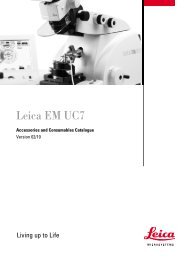Physical Principles of Electron Microscopy: An Introduction to TEM ...
Physical Principles of Electron Microscopy: An Introduction to TEM ...
Physical Principles of Electron Microscopy: An Introduction to TEM ...
You also want an ePaper? Increase the reach of your titles
YUMPU automatically turns print PDFs into web optimized ePapers that Google loves.
70 Chapter 3<br />
where G is a large amplification fac<strong>to</strong>r (or gain), dependent on the design <strong>of</strong><br />
the oscilla<strong>to</strong>r and <strong>of</strong> the step-up transformer. Changing Vi (by altering the<br />
reference voltage V+ in Fig. 3-6) allows V0 <strong>to</strong> be intentionally changed (for<br />
example, from 100 kV <strong>to</strong> 200 kV). However, V0 could drift from its original<br />
value as a result <strong>of</strong> a slow change in G caused by drift in the oscilla<strong>to</strong>r or<br />
diode circuitry, or a change in the emission current Ie for example. Such HV<br />
instability would lead <strong>to</strong> chromatic changes in focusing and is generally<br />
unwanted. To stabilize the high voltage, a feedback resis<strong>to</strong>r R f is connected<br />
between the HV output and the oscilla<strong>to</strong>r input, as in Fig. 3-6. If G were <strong>to</strong><br />
increase slightly, V0 would change in proportion but the increase in feedback<br />
current I f would drive the input <strong>of</strong> the oscilla<strong>to</strong>r more negative, opposing the<br />
change in G. In this way, the high voltage is stabilized by negative feedback,<br />
in<br />
a similar way <strong>to</strong> stabilization <strong>of</strong> the emission current by the bias resis<strong>to</strong>r.<br />
To provide adequate insulation <strong>of</strong> the high-voltage components in the HV<br />
genera<strong>to</strong>r, they are immersed in transformer oil (used in HV power<br />
transformers) or in a gas such as sulfur hexafluoride (SF6) at a few<br />
atmospheres pressure. The high-voltage “tank” also contains the bias resis<strong>to</strong>r<br />
Rb and a transformer that supplies the heating current for a thermionic or<br />
Schottky source. Because the source is operating at high voltage, this second<br />
transformer must also have good insulation between its primary and<br />
secondary windings. Its primary is driven by a second voltage-controlled<br />
oscilla<strong>to</strong>r, whose input is controlled by a potentiometer that the <strong>TEM</strong><br />
opera<strong>to</strong>r turns <strong>to</strong> adjust the filament temperature; see Fig. 3-6.<br />
Although the electric field accelerating the electrons is primarily along<br />
the optic axis, the electric-field lines curve in the vicinity <strong>of</strong> the hole in the<br />
Wehnelt control electrode; see Fig. 3-7. This curvature arises because the<br />
electron source (just above the hole) is less negative than the electrode, by an<br />
amount equal <strong>to</strong> the Wehnelt bias. The curvature results in an electrostatic<br />
lens action that is equivalent <strong>to</strong> a weak convex lens, bringing the electrons <strong>to</strong><br />
a focus (crossover) just below the Wehnelt. Similarly, electric field lines<br />
curve above the hole in the anode plate, giving the equivalent <strong>of</strong> a concave<br />
lens and a diverging effect on the electron beam. As a result, electrons<br />
entering the lens column appear <strong>to</strong> come from a virtual source, whose<br />
diameter is typically 40 �m and divergence semi-angle �1 (relative <strong>to</strong> the<br />
optic axis) about 1 mrad (0.06 degree) in the case <strong>of</strong> a thermionic source.<br />
3.3 Condenser-Lens System<br />
The <strong>TEM</strong> may be required <strong>to</strong> produce a highly magnified (e.g, M = 10 5 )<br />
image <strong>of</strong> a specimen on a fluorescent screen, <strong>of</strong> diameter typically 15 cm. To<br />
ensure that the screen image is not <strong>to</strong>o dim, most <strong>of</strong> the electrons that pass



